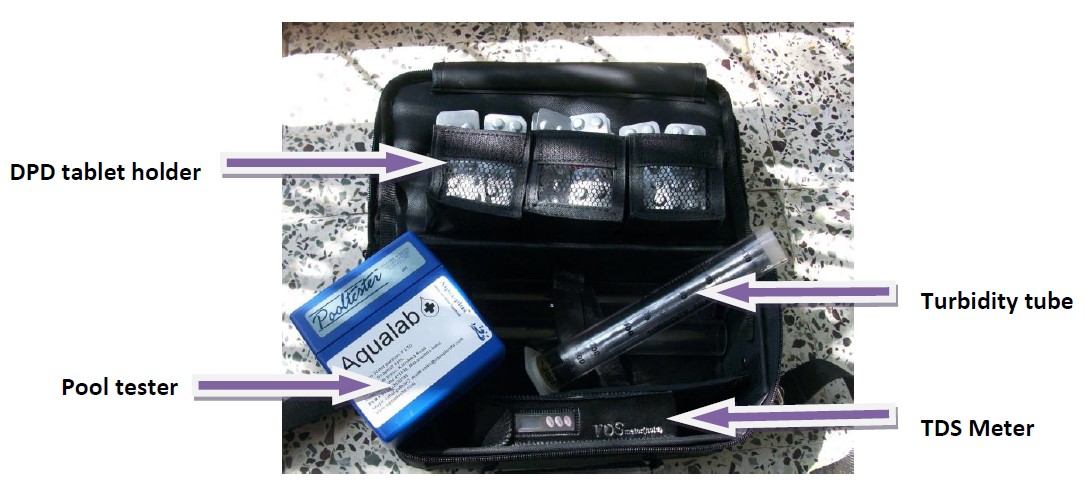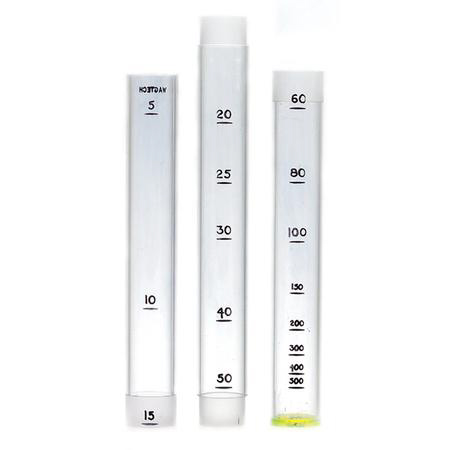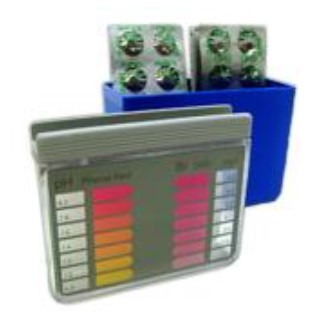
Sampling method
Samples should be taken from locations that are representative of the water distribution network, this includes:
- Source water
- After treatment
- After storage
- Distribution sites
Frequency of sampling depends upon the reasons for analysis, such as a one-off assessment, emergency treatment, long term monitoring. Emergency treatment systems will initially need regular daily assessments to account for variable source waters, thus performance of the treatment and distribution system. Then a monitoring programme can be developed to suit the assessment needs. For long-term monitoring is preformed at monthly intervals, dependant on population size; <5000 = 1 sample per month, 5000 – 100,000 = 1 sample per 5000 per month, > 100,000 = 20 samples per month plus 1 sample per 10,000 population monthly.
The following five tests can be carried out by using this kit:
1. Turbidity
2. TDS (Total dissolved Solids)
3. Total residual chlorine
4. Total free chlorine
5. pH

Procedure to carry out the tests:
Turbidity Test: To measure the turbidity of a water sample using a turbidity tube
The tube is in three parts. Push the three parts together in such a way that the arrow marks of each part join (e.g. B B).
Take a sample of water from the filtration plant or the water source. Hold the tube in one hand and look into the open end with your head about 10 – 20cm above the tube, so you can clearly see the black circle at the bottom of tube. This will ensure an accurate reading.
Slowly pour the water sample into the tube, waiting for air bubbles to rise, until the black circle at the bottom of the tube just disappears.
Stop pouring the water sample into the tube and look at the level of water in the tube. Read the number on the nearest line to the water level. This is the turbidity of the water (NTU). If the black circle becomes invisible in between two readings, take the higher one (e.g. Between 50 and 40, take 50).
Total Dissolved Solids Test: Measure of the combined content of all inorganic and organic substances
- Turn the power ON of the TDS meter, and remove the cap.
- Insert the 2 electrodes at the end of the TDS meter fully into the water, being sure not to insert the whole unit which could cause damage.
- Stir the water a little using the TDS meter or shake it slightly to ensure the electrodes are fully immersed, and that no air bubbles
are attached to the electrodes. - Wait for 5 seconds and a figure will appear, this is your TDS amount.
- Clean with clean water and ensure any excess water is removed.

PH, Free Residual Chlorine and Total Chlorine Test:
- Remove the cap of the pool tester and rinse the testing compartments with the water to be tested.
- Fill the compartments with the sample water to be tested.
- For testing pH: Use a Phenol Red tablet.
- Place the tablet in the pH compartment.
- Replace the cap and shake to dissolve the tablet.
- Hold the pool tester up to light.
- To read the pH value, match the color of the water sample with the pH color code given on the pool tester. The value corresponding to the color is the pH of the water.

For testing Free Residual Chlorine:
- Use a DPD1 tablet.
- Place the tablet in the Cl2 compartment.
- Replace the cap and shake to dissolve the tablet.
- Hold the pool tester up to light.
- To read the residual chlorine value, match the color of the water sample with the residual chlorine color code given on the pool tester. The value corresponding to the color is the residual chlorine in the water.
For testing Total Chlorine:
- Use a DPD3 tablet.
- Place tablet in the Cl2 compartment after reading the free chlorine result (don’t change the sample).
- Replace the cap and shake to dissolve the tablet.
- Hold the pool tester up to light.
- To read the total chlorine value, match the color of the water sample with the color code given for Cl2 compartment on the pool tester. The value corresponding to the color is the total chlorine in the water.
| Parameter | Value |
|---|---|
| Turbidity | < 5 NTU |
| pH | 6.8-8.4 |
| Residual Chlorine | 0.2 – 0.5 mg/l |
| TDS | 500 mg/l |
